Welcome to GREEN
TEA TIME
Takeshi Kusakari and His Woodland Management Project in Hokkaido
Tomakomai City, Hokkaido
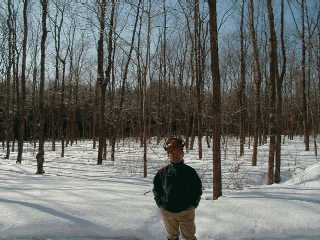 Takeshi Kusakari, forester who has coordinated a unique woodland management project by local volunteer people, kindly wrote this essay on my request. He lives in Tomakomai City in Hokkaido, the northernmost major island of Japan. Besides his work and coordination of woodland management, he also organizes a group of local horticultural people for exchanging information on how to create flower-rich gardens in a rather unfriendly - cool and foggy - climate of their region.
Takeshi Kusakari, forester who has coordinated a unique woodland management project by local volunteer people, kindly wrote this essay on my request. He lives in Tomakomai City in Hokkaido, the northernmost major island of Japan. Besides his work and coordination of woodland management, he also organizes a group of local horticultural people for exchanging information on how to create flower-rich gardens in a rather unfriendly - cool and foggy - climate of their region.
(Kusakari and his local woodland)
To email him please click here!

Recreating Our Local Woodland Based on Aesthetic Values
Takeshi Kusakari, Forester,
Tomakomai City, Hokkaido, Japan
Our city - Tomakomai City is located in the southern part of Hokkaido, which is the northernmost major island of Japan. The city faces the Pacific Ocean - the average altitude of the almost flat terrain is less than 25m above sea level, and the average annual temperature about 7.5 degrees centigrade. Although we do not have much snowfall (less than 30cm/winter), we have relatively more foggy days (44 foggy days/year) than the Japanese average because of our proximity to the sea.
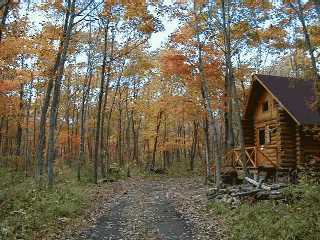 Along the outskirts of our city (about 6km inland from the coast) we still have a huge area of secondary woodland with dominating broadleaved trees which have naturally grown from stump since mature trees were harvested around 40 years ago. The most dominant among these broadleaves, is the konara oak (Quercus serrata), a good coppice tree. Our local woodland has an ecological rarity because it is the northernmost area in Japan where konara oak stands occur.
Along the outskirts of our city (about 6km inland from the coast) we still have a huge area of secondary woodland with dominating broadleaved trees which have naturally grown from stump since mature trees were harvested around 40 years ago. The most dominant among these broadleaves, is the konara oak (Quercus serrata), a good coppice tree. Our local woodland has an ecological rarity because it is the northernmost area in Japan where konara oak stands occur.
(photo: His local woodland and the log house which is the base for Kusakari and friends' management activities)
We manage our woodland to return it to its original state of beauty. Through woodland management, we aim to reclaim our cultural association with wild woodland and also to make participants aware that living in touch with such woodland enriches our life.
To recreate the original woodland we started management of some part of a nearby woodland (total area of woodland 500ha) in 1997. The area was rather overcrowded with trees, and we started thinning it gradually, as well as removing some vines and some dead trees to make habitat piles for invertebrates. Our main aim was to recreate a model woodland with increased aesthetic values.
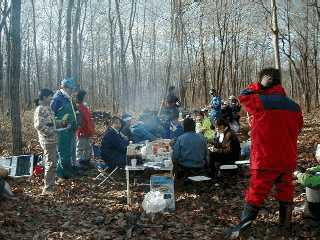 To achieve this, we chose a 'competition' type of management with 6 groups of voluntary people. Each group with different make-up - a group of university students, a female-only group, non-local people living in Sapporo City (the Capital of Hokkaido which is 40km north of the woodland), a group of foresters, etc. - was in charge of a half hectare patch of woodland. On weekends, they came over with their friends and families to meet at a small log house which is our base, then went out to each patch for management work.
To achieve this, we chose a 'competition' type of management with 6 groups of voluntary people. Each group with different make-up - a group of university students, a female-only group, non-local people living in Sapporo City (the Capital of Hokkaido which is 40km north of the woodland), a group of foresters, etc. - was in charge of a half hectare patch of woodland. On weekends, they came over with their friends and families to meet at a small log house which is our base, then went out to each patch for management work.
(photo: lunch time)
We set a few simple rules for this competition such as: (1) In thinning, troubled and less vigorous trees should go first and healthy and vigorous should be kept (2) Target density of trees is about 750 per patch (= 1500/ha) (3) Frequent open fire should be avoided, etc. However, the most important rule, if it was, was 'Let's enjoy our woodland and have fun with your friends and family'. And various recreational events were held such as pizza making with an oven made outside the log house, BBQ, charcoal making workshop, mushroom cultivation, edible woodland plants foray and a following cooking session, and canoeing in an adjacent lake. All these were aimed to re-connect the broken chain between the wild woodland (nature) and us through aesthetic enjoyment and recreation activities in it. Behind these is another aim to achieve both good woodland management and enjoyment in management work felt by participants.
In November 1999, we held an evaluation of the two-year management competition of these 6 groups. Three different judges - a mammal researcher, a psychotherapist knowledgeable about 'sylvatherapy', and a local government official in charge of forestry administration - chose the female-only group as the winner. With the natural friendly atmosphere, the competition was far from serious and fierce one, and in fact it might well have been called a comparison.
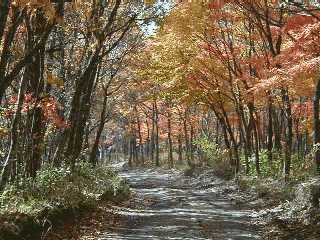 With the rarity value of the northernmost konara oak stands and with the importance to our aesthetic enjoyment, this woodland is also vital to the largest mammal of Japan - It is known that our brown bear (Ursus arctos) uses this woodland as a corridor to move between its western habitat (Lake Shikotsu district) and the eastern area (Hidaka district). A male brown bear was captured and released with a transmitter to monitor its activity. Since 1995 Torajiro, we named him, has been sending important information to researchers.
With the rarity value of the northernmost konara oak stands and with the importance to our aesthetic enjoyment, this woodland is also vital to the largest mammal of Japan - It is known that our brown bear (Ursus arctos) uses this woodland as a corridor to move between its western habitat (Lake Shikotsu district) and the eastern area (Hidaka district). A male brown bear was captured and released with a transmitter to monitor its activity. Since 1995 Torajiro, we named him, has been sending important information to researchers.
(photo: A beautiful autumn color of the trees in the patch after management work (on the right), compared with a rather dark and dull stand without management work (on the left). Allowing sunlight to the ground, good management benefits trees and other wildlife. In the right stand, there should be a greater number and diversity of insects, attracting small mammals and birds, which then attract predators such as birds of prey.)
Our woodland also harbours a population of the sika deer (Cervus nippon yesoensis) and our endemic subspecies of the Russian flying squirrel (Pteromys volans orii). The black woodpecker (Dryocopus martius) also dwells in our trees, and populations of birds of prey are not small. The Lake Utonai Bird Sanctuary is only a few kilometers away from our woodland. We are aware of these wild inhabitants and aim to achieve a harmonious coexistence with them through our woodland management.
Copyright of all text and images belong to Takeshi Kusakari. Text translated by Mari Sato.

- COMMENTS FROM MARI -
I asked Takeshi to write this essay because I was greatly impressed by his philosophy of creating woodland from highly aesthetic viewpoints. He tries woodland creation using techniques of fine art paintings, especially Gainsborough's. 'Western ideas to a Japanese woodland!' you may gasp, but it is very natural for us to try what is good no matter where its origin is. The philosophy of conservation is affected by culture, and culture changes with time. The woodland in Takeshi's mind is the original local woodland with aesthetic values of the West, but the trees, inhabitants and people do not change because of this. Takeshi and his friends are working to create a woodland which satisfies both the needs of animals for their food and shelter and the needs of humans for their happiness and enjoyment .
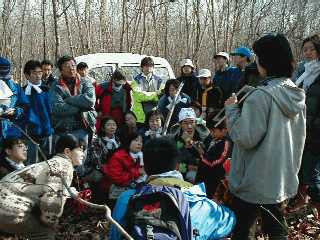 My thoughts about his essay - Is it rather symbolic that the female-only group won the competition? Takeshi told me that during these two years of management work, several members of the group gave birth to babies. While pregnant, they still came to the woodland to look after their patch, and even on the expected delivery date, Mrs Hamada, the group leader, drove to the wood in her Land Rover to do a bit of work!
My thoughts about his essay - Is it rather symbolic that the female-only group won the competition? Takeshi told me that during these two years of management work, several members of the group gave birth to babies. While pregnant, they still came to the woodland to look after their patch, and even on the expected delivery date, Mrs Hamada, the group leader, drove to the wood in her Land Rover to do a bit of work!
(photo: Hamada (on the right with her back facing this side), the leader, and members of the female group which won the competition, surrounded by people from other groups.)
Knowing these episodes, I cannot help thinking of Sheela-na-gig, the goddess of fertility in the Stone Age in Europe. In every ancient civilization, the goddess of fertility is related to earth, and many figurines of them excavated are in a squatting pose, just about to give birth to a baby. All life forms, even big and strong as bears, majestic as trees, and clever but stupid as humans...eventually die and become decomposed by bacteria and fungi to end up with inorganic minerals, which will be absorbed by other organisms and a new life cycle begins. Earth(soil) is really the matrix that all life depends on. Woodland management is about working on the woodland ground and getting your hand with soil. To me it seems in this competition no one could beat pregnant mothers with a new life in them!
Takeshi Kusakari is very happy to hear from you about his project.
Please click here and say Hi! to him by email!
If your PC reads Japanese, please click here to visit Kusakari's site
on his woodland management and flower gardening projects!
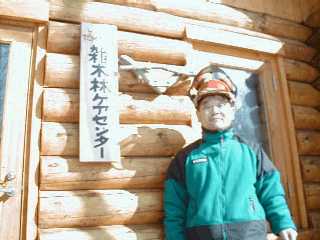
For more information from him about nature and people in Japan, please click his photo.
I am very grateful to Takeshi for kindly writing the essay and allowing me to use these images.
I hope further success of his project and prosperity and happiness to all the members!

Copyright (C) 2000 Mari Sato (except for the text and images by Takeshi Kusakari). All rights reserved.
 Takeshi Kusakari, forester who has coordinated a unique woodland management project by local volunteer people, kindly wrote this essay on my request. He lives in Tomakomai City in Hokkaido, the northernmost major island of Japan. Besides his work and coordination of woodland management, he also organizes a group of local horticultural people for exchanging information on how to create flower-rich gardens in a rather unfriendly - cool and foggy - climate of their region.
Takeshi Kusakari, forester who has coordinated a unique woodland management project by local volunteer people, kindly wrote this essay on my request. He lives in Tomakomai City in Hokkaido, the northernmost major island of Japan. Besides his work and coordination of woodland management, he also organizes a group of local horticultural people for exchanging information on how to create flower-rich gardens in a rather unfriendly - cool and foggy - climate of their region. Along the outskirts of our city (about 6km inland from the coast) we still have a huge area of secondary woodland with dominating broadleaved trees which have naturally grown from stump since mature trees were harvested around 40 years ago. The most dominant among these broadleaves, is the konara oak (Quercus serrata), a good coppice tree. Our local woodland has an ecological rarity because it is the northernmost area in Japan where konara oak stands occur.
Along the outskirts of our city (about 6km inland from the coast) we still have a huge area of secondary woodland with dominating broadleaved trees which have naturally grown from stump since mature trees were harvested around 40 years ago. The most dominant among these broadleaves, is the konara oak (Quercus serrata), a good coppice tree. Our local woodland has an ecological rarity because it is the northernmost area in Japan where konara oak stands occur.  To achieve this, we chose a 'competition' type of management with 6 groups of voluntary people. Each group with different make-up - a group of university students, a female-only group, non-local people living in Sapporo City (the Capital of Hokkaido which is 40km north of the woodland), a group of foresters, etc. - was in charge of a half hectare patch of woodland. On weekends, they came over with their friends and families to meet at a small log house which is our base, then went out to each patch for management work.
To achieve this, we chose a 'competition' type of management with 6 groups of voluntary people. Each group with different make-up - a group of university students, a female-only group, non-local people living in Sapporo City (the Capital of Hokkaido which is 40km north of the woodland), a group of foresters, etc. - was in charge of a half hectare patch of woodland. On weekends, they came over with their friends and families to meet at a small log house which is our base, then went out to each patch for management work.  With the rarity value of the northernmost konara oak stands and with the importance to our aesthetic enjoyment, this woodland is also vital to the largest mammal of Japan - It is known that our brown bear (Ursus arctos) uses this woodland as a corridor to move between its western habitat (Lake Shikotsu district) and the eastern area (Hidaka district). A male brown bear was captured and released with a transmitter to monitor its activity. Since 1995 Torajiro, we named him, has been sending important information to researchers.
With the rarity value of the northernmost konara oak stands and with the importance to our aesthetic enjoyment, this woodland is also vital to the largest mammal of Japan - It is known that our brown bear (Ursus arctos) uses this woodland as a corridor to move between its western habitat (Lake Shikotsu district) and the eastern area (Hidaka district). A male brown bear was captured and released with a transmitter to monitor its activity. Since 1995 Torajiro, we named him, has been sending important information to researchers.  My thoughts about his essay - Is it rather symbolic that the female-only group won the competition? Takeshi told me that during these two years of management work, several members of the group gave birth to babies. While pregnant, they still came to the woodland to look after their patch, and even on the expected delivery date, Mrs Hamada, the group leader, drove to the wood in her Land Rover to do a bit of work!
My thoughts about his essay - Is it rather symbolic that the female-only group won the competition? Takeshi told me that during these two years of management work, several members of the group gave birth to babies. While pregnant, they still came to the woodland to look after their patch, and even on the expected delivery date, Mrs Hamada, the group leader, drove to the wood in her Land Rover to do a bit of work! 